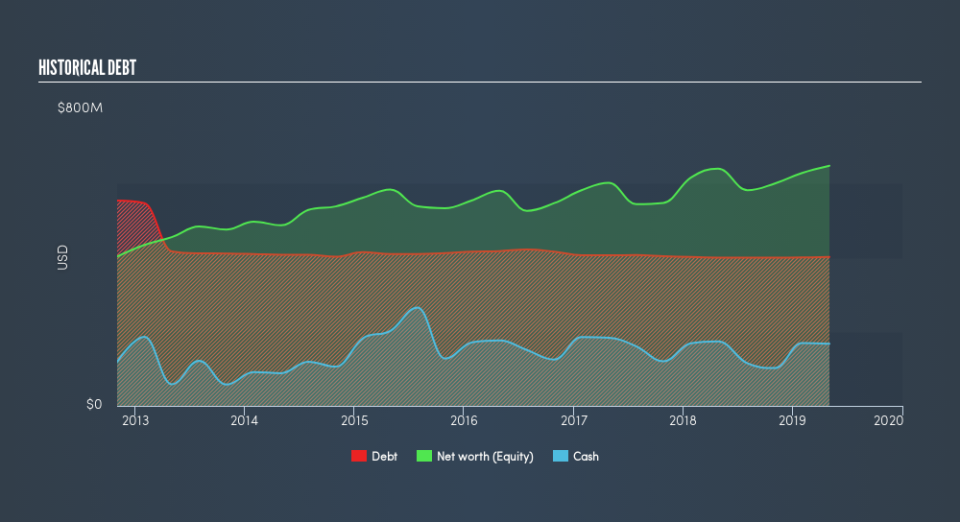Is Cracker Barrel Old Country Store (NASDAQ:CBRL) Using Too Much Debt?

Legendary fund manager Li Lu (who Charlie Munger backed) once said, 'The biggest investment risk is not the volatility of prices, but whether you will suffer a permanent loss of capital.' So it might be obvious that you need to consider debt, when you think about how risky any given stock is, because too much debt can sink a company. We can see that Cracker Barrel Old Country Store, Inc. (NASDAQ:CBRL) does use debt in its business. But the more important question is: how much risk is that debt creating?
What Risk Does Debt Bring?
Debt is a tool to help businesses grow, but if a business is incapable of paying off its lenders, then it exists at their mercy. Part and parcel of capitalism is the process of 'creative destruction' where failed businesses are mercilessly liquidated by their bankers. While that is not too common, we often do see indebted companies permanently diluting shareholders because lenders force them to raise capital at a distressed price. Of course, debt can be an important tool in businesses, particularly capital heavy businesses. The first thing to do when considering how much debt a business uses is to look at its cash and debt together.
See our latest analysis for Cracker Barrel Old Country Store
What Is Cracker Barrel Old Country Store's Debt?
The chart below, which you can click on for greater detail, shows that Cracker Barrel Old Country Store had US$401.7m in debt in May 2019; about the same as the year before. However, because it has a cash reserve of US$167.6m, its net debt is less, at about US$234.1m.
How Healthy Is Cracker Barrel Old Country Store's Balance Sheet?
We can see from the most recent balance sheet that Cracker Barrel Old Country Store had liabilities of US$363.8m falling due within a year, and liabilities of US$583.3m due beyond that. Offsetting these obligations, it had cash of US$167.6m as well as receivables valued at US$22.2m due within 12 months. So it has liabilities totalling US$757.3m more than its cash and near-term receivables, combined.
Since publicly traded Cracker Barrel Old Country Store shares are worth a total of US$3.95b, it seems unlikely that this level of liabilities would be a major threat. Having said that, it's clear that we should continue to monitor its balance sheet, lest it change for the worse.
We use two main ratios to inform us about debt levels relative to earnings. The first is net debt divided by earnings before interest, tax, depreciation, and amortization (EBITDA), while the second is how many times its earnings before interest and tax (EBIT) covers its interest expense (or its interest cover, for short). The advantage of this approach is that we take into account both the absolute quantum of debt (with net debt to EBITDA) and the actual interest expenses associated with that debt (with its interest cover ratio).
Cracker Barrel Old Country Store has a low net debt to EBITDA ratio of only 0.60. And its EBIT easily covers its interest expense, being 16.9 times the size. So we're pretty relaxed about its super-conservative use of debt. On the other hand, Cracker Barrel Old Country Store saw its EBIT drop by 2.6% in the last twelve months. If earnings continue to decline at that rate the company may have increasing difficulty managing its debt load. When analysing debt levels, the balance sheet is the obvious place to start. But it is future earnings, more than anything, that will determine Cracker Barrel Old Country Store's ability to maintain a healthy balance sheet going forward. So if you're focused on the future you can check out this free report showing analyst profit forecasts.
But our final consideration is also important, because a company cannot pay debt with paper profits; it needs cold hard cash. So we clearly need to look at whether that EBIT is leading to corresponding free cash flow. During the last three years, Cracker Barrel Old Country Store produced sturdy free cash flow equating to 69% of its EBIT, about what we'd expect. This cold hard cash means it can reduce its debt when it wants to.
Our View
Cracker Barrel Old Country Store's interest cover suggests it can handle its debt as easily as Cristiano Ronaldo could score a goal against an under 14's goalkeeper. But truth be told we feel its EBIT growth rate does undermine this impression a bit. All these things considered, it appears that Cracker Barrel Old Country Store can comfortably handle its current debt levels. On the plus side, this leverage can boost shareholder returns, but the potential downside is more risk of loss, so it's worth monitoring the balance sheet. Of course, we wouldn't say no to the extra confidence that we'd gain if we knew that Cracker Barrel Old Country Store insiders have been buying shares: if you're on the same wavelength, you can find out if insiders are buying by clicking this link.
If you're interested in investing in businesses that can grow profits without the burden of debt, then check out this free list of growing businesses that have net cash on the balance sheet.
We aim to bring you long-term focused research analysis driven by fundamental data. Note that our analysis may not factor in the latest price-sensitive company announcements or qualitative material.
If you spot an error that warrants correction, please contact the editor at editorial-team@simplywallst.com. This article by Simply Wall St is general in nature. It does not constitute a recommendation to buy or sell any stock, and does not take account of your objectives, or your financial situation. Simply Wall St has no position in the stocks mentioned. Thank you for reading.

